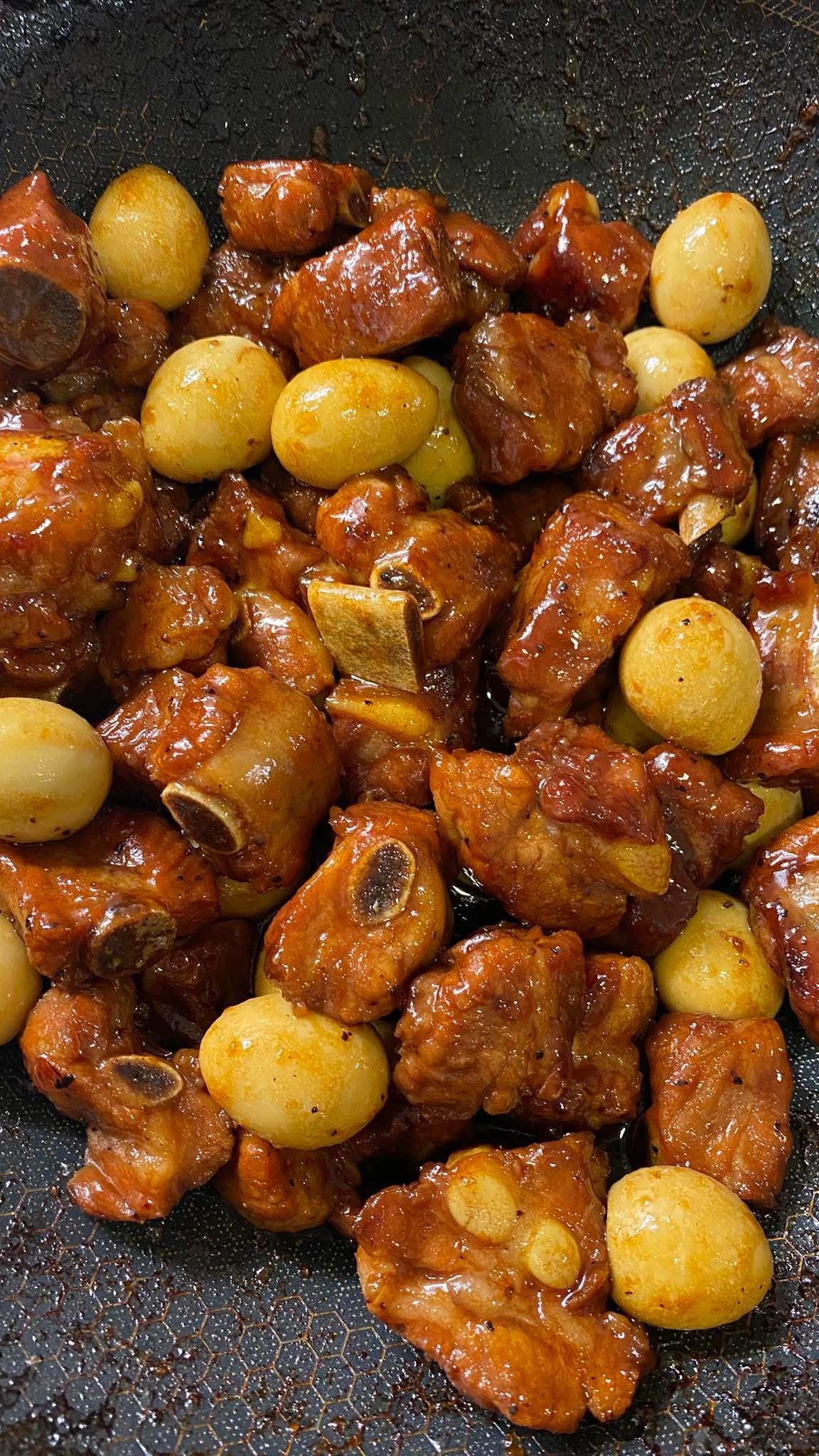My Mom’s Legacy Dish—Slow Simmered, Deeply Flavorful, and Full of Soul.
Hey foodie fam!
This one’s for all of you who asked, “When are you dropping your mom’s caramelized pork recipe?” Well, the wait is over. Today, I’m taking you straight into the heart of my Vietnamese kitchen—a space where tradition, memory, and flavor collide.
This dish, Thịt Kho Trứng Cút, is an iconic southern Vietnamese comfort food. Traditionally served during Tết (Vietnamese Lunar New Year), it symbolizes abundance, warmth, and the hope for a sweet year ahead. Though we now enjoy it year-round, it’s still the kind of meal we save for special family gatherings—a true labor of love.
It’s sticky, sweet, salty, and umami-packed, thanks to a deep caramel sauce that hugs each tender piece of pork. And the quail eggs? Total flavor bombs. Let’s dive in and savor every step of this iconic dish—the way my mom taught me.
⸻
Ingredients (serves 4-6)
Main Ingredients:
• 2 ½ lbs pork spare ribs, cut into bite-size chunks (or substitute with pork belly or shoulder for a softer bite)
• 1 can (15-18) quail eggs, drained and rinsed (or 12 hard-boiled chicken eggs)
• 1/3 cup granulated sugar (for caramelizing)
• 2 tablespoons fish sauce (the soul of Vietnamese cooking)
• 2 tablespoons soy sauce
• 1 tablespoon oyster sauce (optional but boosts umami)
• 1 teaspoon black pepper
• 4 cloves garlic, minced
• 2 shallots, thinly sliced
• 1 tablespoon cooking oil (neutral oil like canola or avocado oil)
• 1 ½ cups coconut water (for authentic sweetness and depth)
• 1 cup water (as needed)
Optional Add-ons:
• Thai chili or jalapeño slices (for heat)
• A splash of caramel color (nước màu) for deeper hue
• Fresh green onions or cilantro for garnish
• Steamed jasmine rice (a non-negotiable pairing)
⸻
Success Tips Before You Start:
• Caramelization is key: Take your time with the sugar in step one—it builds the entire flavor base.
• Don’t rush the simmer: Low and slow is the name of the game. Give the pork time to absorb all the saucy goodness.
• Use coconut water: It’s a traditional Vietnamese trick for naturally sweet depth that cuts through the richness.
• Balance the flavors: Taste and adjust. The final dish should hit salty, sweet, savory, and slightly bitter from the caramel.
• Indulge with intention: This isn’t an everyday dish—but when you do make it, make it count.
⸻
Step-by-Step Instructions
Step 1: Caramelize the Sugar
In a heavy-bottomed pot or deep skillet, add 1/3 cup sugar over medium heat. Let it melt slowly—no stirring—until it turns a rich amber brown. Swirl the pan gently if needed. As soon as it reaches that deep caramel color, immediately add the pork and toss to coat.
Step 2: Build the Flavor Base
Add garlic, shallots, fish sauce, soy sauce, oyster sauce, and black pepper. Stir-fry for 3-5 minutes until aromatic and well-coated. Your kitchen should already smell like magic.
Step 3: Simmer and Soften
Pour in the coconut water and enough regular water to just cover the pork. Bring to a boil, then reduce to low and simmer uncovered for 45-60 minutes. Skim off any foam.
Step 4: Add the Quail Eggs
Once the pork is tender and the sauce has reduced by half, add the quail eggs. Simmer another 10-15 minutes, allowing the eggs to soak in the caramel sauce.
Step 5: Final Taste Test
Adjust seasoning with extra fish sauce or sugar if needed. The sauce should be rich, slightly sticky, and bursting with balanced flavors.
⸻
What It Should Look & Feel Like
Golden-hued sauce clings lovingly to each rib. The pork is fall-apart tender, the quail eggs marbled and full of flavor. Served over a hot bed of jasmine rice, it’s that Sunday-supper-meets-holiday-luxury vibe.
⸻
Nutritional Info (Approximate per Serving):
• Calories: 420
• Protein: 28g
• Carbs: 14g
• Fat: 27g
• Sugar: 7g
• Sodium: High—opt for low-sodium soy sauce if needed
Health Hack: This is definitely a “treat yourself” kind of dish. To lighten it up, swap pork ribs for lean pork shoulder, use less sugar, and boil the quail eggs separately to remove excess fat.
⸻
In Conclusion:
This dish isn’t just food—it’s a whole vibe.
It’s the slow-simmered richness of my childhood.
It’s laughter echoing in the kitchen.
It’s mom’s voice telling me when the caramel is “just right.”
In every bite, you taste time, tradition, and love. And though it’s rich and indulgent, making this with intention—savoring every stage, and sharing it with people you love—is the healthiest kind of cooking I know.
⸻
Final Recommendations:
• Serve with: Pickled mustard greens or a simple cucumber salad for freshness.
• Leftovers: Even better the next day—store in the fridge up to 3 days.
• Pair with: An iced jasmine tea or even a crisp sparkling water with lime.
